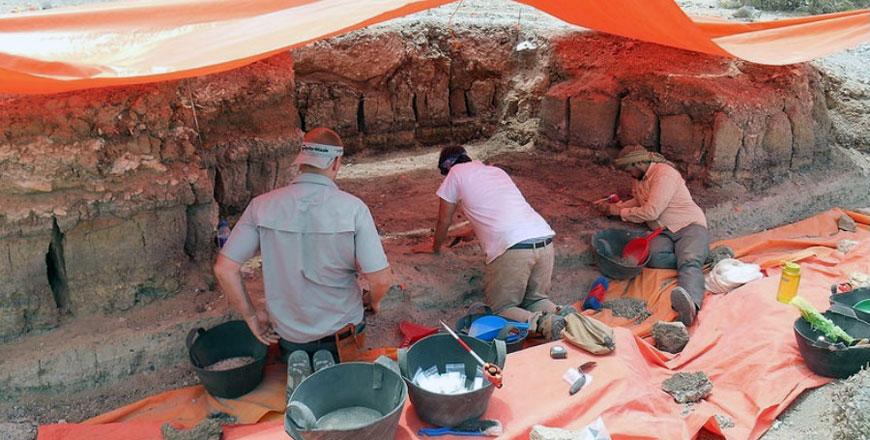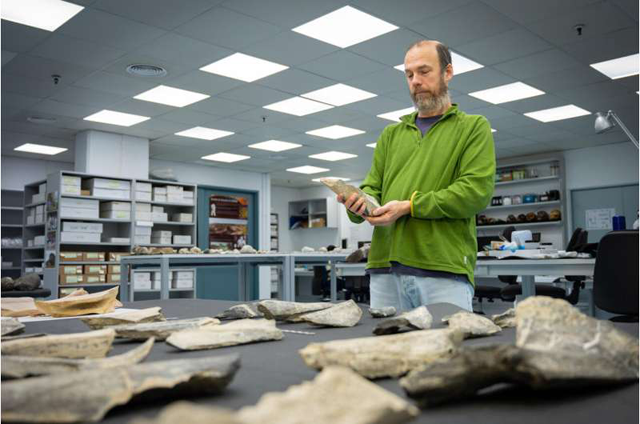You are here
Archaeologists make world-first discovery about Stone Age tools in Jordan
By JT - Aug 09,2016 - Last updated at Aug 09,2016

A team of archaeologists from the Hashemite University and the University of Victoria carry out excavation in Azraq in 2015 (Photo courtesy of Victoria University)
AMMAN – A team of archaeologists from the Canadian University of Victoria (UVic) has recently revealed “surprisingly sophisticated” adaptations by early humans living 250,000 years ago in a former oasis near Azraq.
The new research, published in the Journal of Archaeological Science, was made by a team led by paleoanthropologist April Nowell of the British Columbia-based UVic, the university said in a statement on Monday.
The research team from UVic and partner universities in the US and Jordan has found the oldest evidence of protein residue — the residual remains of butchered animals including horses, rhinoceros, wild cattle and ducks — on stone tools.
“The discovery draws startling conclusions about how these early humans subsisted in a very demanding habitat, thousands of years before Homo sapiens first evolved in Africa,” said the university.
The team excavated 10,000 stone tools over three years from what is now a desert in the northeast of Jordan, but was once a wetland that became increasingly arid habitat 250,000 years ago.
Azraq is some 100 kilometres east of Amman.
The team closely examined 7,000 of these tools, including scrapers, flakes, projectile points and hand axes (commonly known as the “Swiss army knife” of the Palaeolithic period), with 44 subsequently selected as candidates for testing.
Of this sample, 17 tools tested positive for protein residue, like blood and other animal products.
“Researchers have known for decades about carnivorous behaviours by tool-making hominins dating back 2.5 million years, but now, for the first time, we have direct evidence of exploitation by our Stone Age ancestors of specific animals for subsistence,” said Nowell.
“The hominins in this region were clearly adaptable and capable of taking advantage of a wide range of available prey, from rhinoceros to ducks, in an extremely challenging environment.
“What this tells us about their lives and complex strategies for survival, such as the highly variable techniques for prey exploitation, as well as predator avoidance and protection of carcasses for food, significantly diverges from what we might expect from this extinct species,” she continued.
“It opens up our ability to ask questions about how Middle Pleistocene hominins lived in this region and it might be a key to understanding the nature of interbreeding and population dispersals across Eurasia with modern humans and archaic populations such as Neanderthals,” the paleoanthropologist added.
Another result of the study is the potential to revolutionise what researchers know about early hominin diets. “Other researchers with tools as old or older than these tools from sites in a variety of different environmental settings may also have success when applying the same technique to their tools, especially in the absence of animal remains at those sites,” said Nowell.
The research was fully funded by a grant from the Social Sciences and Humanities Research Council of Canada, UVic noted.
Related Articles
AMMAN — Former marshes near Azraq and their "assemblages of stone tools" may offer some clues about the Paleolithic period in Jordan,
PARIS — Our ancestors were making tools out of bones 1.5 million years ago, winding back the clock for this important moment in human evolut
Flower power may have meant the difference between life and death for some of the extinct giants of the Ice Age, including the mighty woolly mammoth and woolly rhinoceros.

















